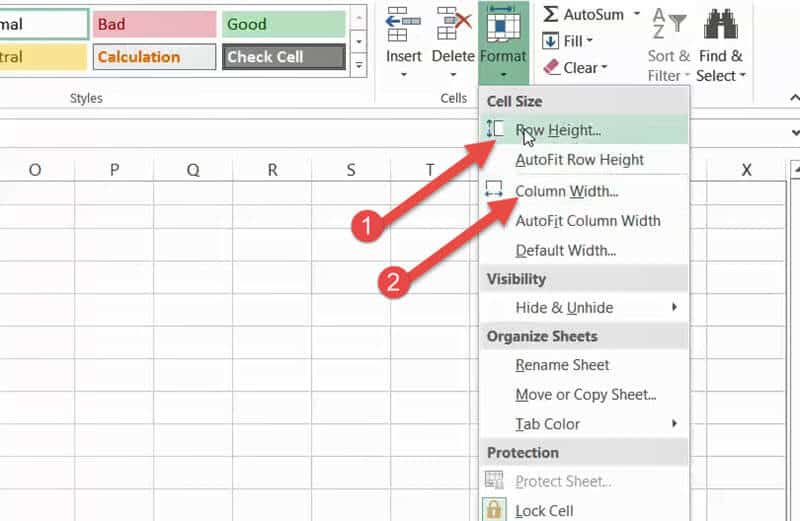If you find yourself needing to expand or reduce Excel’s row widths and column heights, there are several ways to adjust them. The table below shows the minimum, maximum and default sizes for each based on a point scale.
|
Type |
Min |
Max |
Default |
|---|---|---|---|
|
Column |
0 (hidden) |
255 |
8.43 |
|
Row |
0 (hidden) |
409 |
15.00 |
Notes:
-
If you are working in Page Layout view (View tab, Workbook Views group, Page Layout button), you can specify a column width or row height in inches, centimeters and millimeters. The measurement unit is in inches by default. Go to File > Options > Advanced > Display > select an option from the Ruler Units list. If you switch to Normal view, then column widths and row heights will be displayed in points.
-
Individual rows and columns can only have one setting. For example, a single column can have a 25 point width, but it can’t be 25 points wide for one row, and 10 points for another.

Set a column to a specific width
-
Select the column or columns that you want to change.
-
On the Home tab, in the Cells group, click Format.
-
Under Cell Size, click Column Width.
-
In the Column width box, type the value that you want.
-
Click OK.
Tip: To quickly set the width of a single column, right-click the selected column, click Column Width, type the value that you want, and then click OK.
-
Select the column or columns that you want to change.
-
On the Home tab, in the Cells group, click Format.
-
Under Cell Size, click AutoFit Column Width.
Note: To quickly autofit all columns on the worksheet, click the Select All button, and then double-click any boundary between two column headings.
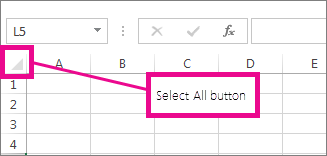
-
Select a cell in the column that has the width that you want to use.
-
Press Ctrl+C, or on the Home tab, in the Clipboard group, click Copy.
-
Right-click a cell in the target column, point to Paste Special, and then click the Keep Source Columns Widths
button.
The value for the default column width indicates the average number of characters of the standard font that fit in a cell. You can specify a different number for the default column width for a worksheet or workbook.
-
Do one of the following:
-
To change the default column width for a worksheet, click its sheet tab.
-
To change the default column width for the entire workbook, right-click a sheet tab, and then click Select All Sheets on the shortcut menu.
-
-
On the Home tab, in the Cells group, click Format.
-
Under Cell Size, click Default Width.
-
In the Standard column width box, type a new measurement, and then click OK.
Do one of the following:
-
To change the width of one column, drag the boundary on the right side of the column heading until the column is the width that you want.
-
To change the width of multiple columns, select the columns that you want to change, and then drag a boundary to the right of a selected column heading.
-
To change the width of columns to fit the contents, select the column or columns that you want to change, and then double-click the boundary to the right of a selected column heading.
-
To change the width of all columns on the worksheet, click the Select All button, and then drag the boundary of any column heading.
-
Select the row or rows that you want to change.
-
On the Home tab, in the Cells group, click Format.
-
Under Cell Size, click Row Height.
-
In the Row height box, type the value that you want, and then click OK.
-
Select the row or rows that you want to change.
-
On the Home tab, in the Cells group, click Format.
-
Under Cell Size, click AutoFit Row Height.
Tip: To quickly autofit all rows on the worksheet, click the Select All button, and then double-click the boundary below one of the row headings.

Do one of the following:
-
To change the row height of one row, drag the boundary below the row heading until the row is the height that you want.
-
To change the row height of multiple rows, select the rows that you want to change, and then drag the boundary below one of the selected row headings.
-
To change the row height for all rows on the worksheet, click the Select All button, and then drag the boundary below any row heading.
-
To change the row height to fit the contents, double-click the boundary below the row heading.
Top of Page
If you prefer to work with column widths and row heights in inches, you should work in Page Layout view (View tab, Workbook Views group, Page Layout button). In Page Layout view, you can specify a column width or row height in inches. In this view, inches are the measurement unit by default, but you can change the measurement unit to centimeters or millimeters.
-
In Excel 2007, click the Microsoft Office Button
> Excel Options> Advanced.
-
In Excel 2010, go to File > Options > Advanced.
Set a column to a specific width
-
Select the column or columns that you want to change.
-
On the Home tab, in the Cells group, click Format.
-
Under Cell Size, click Column Width.
-
In the Column width box, type the value that you want.
-
Select the column or columns that you want to change.
-
On the Home tab, in the Cells group, click Format.
-
Under Cell Size, click AutoFit Column Width.
Tip To quickly autofit all columns on the worksheet, click the Select All button and then double-click any boundary between two column headings.

-
Select a cell in the column that has the width that you want to use.
-
On the Home tab, in the Clipboard group, click Copy, and then select the target column.
-
On the Home tab, in the Clipboard group, click the arrow below Paste, and then click Paste Special.
-
Under Paste, select Column widths.
The value for the default column width indicates the average number of characters of the standard font that fit in a cell. You can specify a different number for the default column width for a worksheet or workbook.
-
Do one of the following:
-
To change the default column width for a worksheet, click its sheet tab.
-
To change the default column width for the entire workbook, right-click a sheet tab, and then click Select All Sheets on the shortcut menu.
-
-
On the Home tab, in the Cells group, click Format.
-
Under Cell Size, click Default Width.
-
In the Default column width box, type a new measurement.
Tip If you want to define the default column width for all new workbooks and worksheets, you can create a workbook template or a worksheet template, and then base new workbooks or worksheets on those templates. For more information, see Save a workbook or worksheet as a template.
Do one of the following:
-
To change the width of one column, drag the boundary on the right side of the column heading until the column is the width that you want.
-
To change the width of multiple columns, select the columns that you want to change, and then drag a boundary to the right of a selected column heading.
-
To change the width of columns to fit the contents, select the column or columns that you want to change, and then double-click the boundary to the right of a selected column heading.
-
To change the width of all columns on the worksheet, click the Select All button, and then drag the boundary of any column heading.
-
Select the row or rows that you want to change.
-
On the Home tab, in the Cells group, click Format.
-
Under Cell Size, click Row Height.
-
In the Row height box, type the value that you want.
-
Select the row or rows that you want to change.
-
On the Home tab, in the Cells group, click Format.
-
Under Cell Size, click AutoFit Row Height.
Tip To quickly autofit all rows on the worksheet, click the Select All button and then double-click the boundary below one of the row headings.

Do one of the following:
-
To change the row height of one row, drag the boundary below the row heading until the row is the height that you want.
-
To change the row height of multiple rows, select the rows that you want to change, and then drag the boundary below one of the selected row headings.
-
To change the row height for all rows on the worksheet, click the Select All button, and then drag the boundary below any row heading.
-
To change the row height to fit the contents, double-click the boundary below the row heading.
Top of Page
See Also
Change the column width or row height (PC)
Change the column width or row height (Mac)
Change the column width or row height (web)
How to avoid broken formulas
Change the column width or row height in Excel
You can manually adjust the column width or row height or automatically resize columns and rows to fit the data.
Note: The boundary is the line between cells, columns, and rows. If a column is too narrow to display the data, you will see ### in the cell.
Resize rows
-
Select a row or a range of rows.
-
On the Home tab, select Format > Row Width (or Row Height).
-
Type the row width and select OK.
Resize columns
-
Select a column or a range of columns.
-
On the Home tab, select Format > Column Width (or Column Height).
-
Type the column width and select OK.
Automatically resize all columns and rows to fit the data
-
Select the Select All button
at the top of the worksheet, to select all columns and rows.
-
Double-click a boundary. All columns or rows resize to fit the data.
Need more help?
You can always ask an expert in the Excel Tech Community or get support in the Answers community.
See Also
Insert or delete cells, rows, and columns
Need more help?
Want more options?
Explore subscription benefits, browse training courses, learn how to secure your device, and more.
Communities help you ask and answer questions, give feedback, and hear from experts with rich knowledge.
A neat looking worksheet is always better than a shabby and unorganized one. You can tell if a sheet has been handled repeatedly by different people by just one look at it.
You will find it unorganized and shabby, often with rows and columns of varying sizes. Nobody likes that!
Maybe you were the one destined to put the sheet back in shape and make it nice and neat with trimmed cells that are evenly sized! In this Excel tutorial, we will help you do just that.
We will show you how you can set the column width and row height of all your cells so that they are all the same size. We will also show you how you can make sure that all the cells are well fitted around the content for added neatness.
In the end, we will show you how you can speed up this process by using simple VBA macro codes.
Setting the Column Width and Row Height of All Cells to a Specific Size
When you open a fresh Excel worksheet, you will always find the cells to be of a specific width and height by default. The default row height is 15 and the default column width is 8.43.
However, as you work on these cells, the heights and widths of the cells keep expanding to accommodate the contents of your cells.
In the end, what you get is a hodgepodge of cells of varying heights and widths.
Giving these cell sizes some uniformity though is quite easy. Here’s how you can achieve this.
If you want to resize your entire worksheet, do the following:
- Click on the ‘Select All’ button on the top-left of the Excel window.
- Set the Column width for all the cells. Right-click on any column header. Select ‘Column Width’ from the popup menu. Enter the size to which you want to set all the columns.
- Set the Row height for all the cells. Right-click on any row, select ‘Row Height’ from the popup menu. Enter the size to which you want to set all the rows.
That’s all. You will get all your cells uniformly adjusted to your required size.
Setting the Column Width and Row Height of Selected Cells to a Specific Size
If you want to resize only selected cells, do the following:
- Drag and select all your required cells. If there are a lot of cells that you need to select, click on the cell at the top left corner of your required selection, then pressing down on the SHIFT key, click on the cell at the bottom right corner of your required selection.
- Set the column width for the selected cells. Under the Home tab, select ‘Format’ (from the Cells group). Select ‘Column Width’ and enter the size to which you want to set all the columns in the small ‘Column Width’ window that appears.
- Set the row height for the selected cells. Under the Home tab, select ‘Format’ (from the Cells group). Select ‘Row Height’ and enter the size to which you want to set all the columns in the small ‘Row Height’ window that appears.
Your selected cells will now be equally resized to your requirement.
Applying the Same Column Width and Row Height by Using a Mouse
- Apply the same column width by selecting the column headers of all the cells you want to adjust.
- Drag the boundary of any one of the selected column headers to the width you like. When you release the mouse button, you will find all the other selected columns resized to the same width.
- Similarly, you can apply the same row height by selecting the row headers of all the cells you want to adjust.
- Drag the boundary of any one of the selected row headers to the height you like. When you release the mouse button, you will find all the other selected rows resized to the same height.
Changing the Column Width and Row Height to Auto-fit the Contents
In case you want to further make your sheet look neat, you can adjust the cell sizes to the height/ width of the cell with the highest height/ width.
- Select the column headers of the cells you want to adjust.
- Double click the boundary of any one of the selected column headers. You will find all the selected columns adjusted to fit the contents of the widest cell in each column.
- Similarly, select the row headers of the cells you want to adjust
- Double click the boundary of any one of the selected row headers. You will find all the selected rows adjusted to fit the contents of the cell with the most height in each row.
Using VBScript
If you are comfortable using VBScript, you can easily speed up the above processes by copying and pasting a short script into your developer window.
- Select the rows and columns that you want to adjust.
- From the Developer Menu Ribbon, select Visual Basic.
- Once your VBA window opens, Click Insert->Module. Now you can start adding your code.
Using VBScript to Set the Selected Cells to a Specific Size
Let us assume that you want to set all the selected cells to a column width of 10 and a row height of 20.
You can then copy and paste the following lines to your Developer window:
Sub makeequalsize() Selection.ColumnWidth = 10 Selection.RowHeight = 20 End Sub
You can also choose to specify the range of cells that you want to set to a specific size.
For example, if you want to set the size for the range A2 to G12, you can use the following code:
Sub makeequalsize()
Range("A2:G12").ColumnWidth = 10
Range("A2:G12").RowHeight = 20
End Sub
Note: You can replace the column width and row height according to your preference.
Using VBScript to Set the Selected Cells to the Same Size as a Specific Cell
If you have a reference cell with the perfect size that you want to copy to all other cells in your selection, say cell B5, then copy and paste the following lines:
Sub makeequalsize()
Selection.ColumnWidth = Columns("B").ColumnWidth
Selection.RowHeight = Rows("5").RowHeight
End Sub
You can also choose to specify the range of cells that you want to set to the size of a particular cell.
For example, if you want to set the size for the range A2 to G12 to the size of cell B5, you can use the following code:
Sub makeequalsize()
Range("A2:G12").ColumnWidth = Columns("B").ColumnWidth
Range("A2:G12").RowHeight = Rows("5").RowHeight
End Sub
Note: You can replace the column name “B” and row number “5” with the corresponding column name and row number of your preferred cell.
Using VBScript to Auto-fit the Contents of All Selected Cells
To adjust the cell sizes to the height/ width of the cell with the highest height/ width, you can use AutoFit as follows:
To autofit the column width of the selected cells, copy-paste the following lines:
Sub autofitColumns() Selection.Columns.AutoFit End Sub
To autofit the row height of selected cells, copy-paste the following lines:
Sub autofitRows() Selection.Rows.AutoFit End Sub
To autofit both, you can combine the two commands as follows:
Sub autofitAllCells() Selection.Columns.AutoFit Selection.Rows.AutoFit End Sub
Conclusion
In this tutorial, you saw how you can adjust cell sizes to make your worksheet look uniform and neat.
We have shown you how you can either set the cells to a specific height and width or adjust the height and width to match that of a specific cell.
In the end, we also showed how you can use VBA Script to programmatically and quickly get this done so that you can get this done for multiple sheets quickly.
Other Excel tutorials you may find useful:
- How to Find Merged Cells in Excel
- How to Subtract Multiple Cells from One Cell in Excel
- How to Select Every Other Cell in Excel
- How to Select Alternate Columns in Excel (or every Nth Column)
- How to Set a Row to Print on Every Page in Excel
- How to Press Enter in Excel and Stay in the Same Cell?
- How to Show Ruler in Excel? (Ruler Grayed Out)
- Autofit Column Width in Excel (Shortcut)
Whenever you work on an Excel spreadsheet, in most cases you will need to change the size of the cells to be able to view all the content they contain. But, to do this, and due to the tabular structure of the spreadsheet, you will of course have to resize the entire column or row to which the cell belongs.
In the following, I will show you how to know the current size of a column or row, what are the minimum and maximum sizes of a cell, how to resize a column or a row (with examples), and how to make multiple columns or rows the same size (with examples). I will also discuss the issue that is sometimes caused by the autofit feature of Excel compared to the manual resizing of columns width and rows height, and how to solve it.
So, let’s now start with how to actually know the current width of a column or height of a row.
A/ How to know the column width or row height in Excel
1- How to know the current width of a column in Excel
To know the width of a column in Excel, hold down the click on the right boundary of its header, and Excel displays its width in a tooltip. Or, click a cell of the column; go to “Home” tab and click “Format” drop-down of the “Cells” group, then click “Column Width”. Excel displays the width of the column in the “Column Width” dialog.
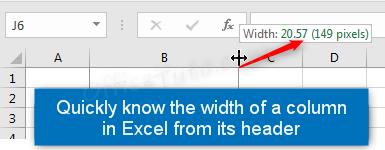
Or
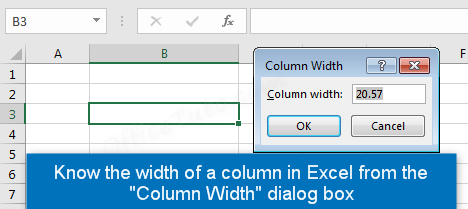
The unit of the column width is in characters; i.e., how many zero characters fit in this width in one line, in the “Normal” view, for the default font and size (Calibri – size 11). For more insight on how the columns width is calculated and on its unit, check What Are Units of Column Width and Row Height in Excel.
In my opinion, even though the first method of clicking the right boundary of a column header to display the tooltip is faster to find the current column width, but it may lead to unintentionally drag the mouse to the right or left side, which will change the width of the column. I prefer to use the “Format” dropdown method when I don’t want the current structure of my columns to be affected.
2- How to know the current height of a row in Excel
To know the height of a row in Excel, hold down the click on the bottom boundary of its header, and Excel displays its height in a tooltip. Or, click a cell of the row; go to “Home” tab and click “Format” drop-down of the “Cells” group, then click “Row Height”. Excel displays the height of the row in the “Row Height” dialog.
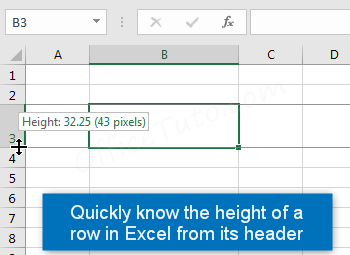
Or
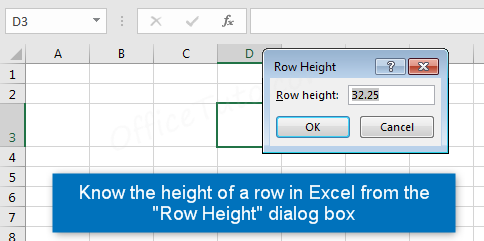
The unit of the row height is in points. For more in-depth information on how the rows height is calculated and on its unit, check What Are Units of Column Width and Row Height in Excel.
As you may notice, the first method of clicking the right boundary of a row header to display the tooltip is faster to find the current row height, but it may lead to unintentionally drag the mouse to the top or bottom side, which will change the height of the row. I think that using the “Format” dropdown method is better when you don’t want the current structure of your rows to be affected.
B/ Minimum and maximum sizes of cells in Excel
1- Minimum and maximum column width in Excel
The column width in the normal view of Excel is calculated in characters (how many zero characters fit in).
The minimum size of a column width in Excel is 0, which is the equivalent of hiding the column.
The maximum size of a column width in Excel is 255 characters (255 of zero characters) in the “Normal” view, for the default font and size (Calibri – size 11); or 20.03 inches in the “Page Layout” view (for a 100% scaling).
In the Normal view, the 255 characters is not the number of characters a cell can contain (a cell can contain up to 32,767 characters); it’s the maximum number of characters (zero characters) a column can show in its width in one line. If there are more characters, they will just overflow to the right of the cell in the same line, or to more lines if the wrap text feature is applied.
In the example illustrated below, I show you how the maximum column width in Excel fits with 255 of zero characters, in the default font and size Calibri 11.

Of course, when you change the font, the size, or the style (Bold, Italic), the maximum number of characters a column can show in its width in one line will change.
If you try to set a column width greater than 255 characters, Excel will refuse and display an error message; see the screenshot below.
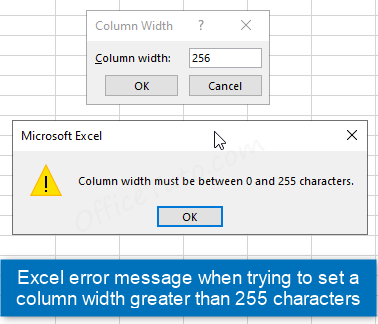
2- Minimum and maximum row height in Excel
The row height in the normal view of Excel is calculated in points.
The minimum size of a row height in Excel is 0, which is the equivalent of hiding the row.
The maximum size of a row height in Excel is 409.5 points in the “Normal” view, or 5.69 inches in the “Page layout” view (for a 100% scaling).
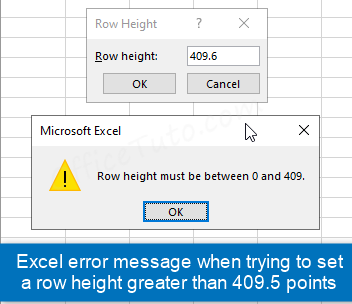
Now, after learning how to know the current width of a column and height of a row, as well as learning the minimum and maximum sizes allowed in Excel, let’s see how to change this column width or row height in Excel.
C/ How to resize a column in Excel
The default column width in Excel is 8.43 characters (8.43 of zero characters) in the “Normal” view, for the default font and size (Calibri – size 11); or 0.72 inches in the “Page Layout” view (for a 100% scaling).
So, when you create a new spreadsheet, columns will have the default width; but you can of course change this width to the size you want.
Note also that you can set a new default width for columns in Excel; I detailed this in How To Set a New Default Column Width and Row Height in Excel.
Let’s see now how to change the column width in Excel.
There are 3 ways to resize columns in Excel:
- Dynamically, through the mouse drag and drop.
- Precisely, via the right click or the ribbon.
- Automatically fit the content of the cells (Autofit).
I will detail each method in the following sections:
1- How to resize columns in Excel with drag and drop
In this first method of resizing a column or multiple columns in Excel, I will use the drag and drop of the mouse.
To resize a column in Excel using the drag and drop of the mouse:
- Place the cursor on the right boundary of the column’s heading.
- The cursor is transformed to a double-sided arrow.
- Click and drag this right boundary to the right to widen the column, or to the left to narrow it.
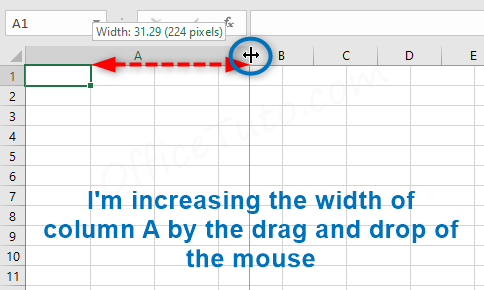
To resize multiple columns in Excel using the drag and drop of the mouse:
- Select first the columns by their headings.
- Place the cursor on a boundary of any of these headings.
- The cursor is transformed to a double-sided arrow.
- Click and drag this boundary to the right to widen the columns, or to the left to narrow them.
- Excel changes the width of all selected columns.
2- How to precisely resize columns in Excel via the dialog box
You can resize a column or multiple columns in Excel with a precise size, using the right click or the ribbon.
a- How to precisely resize columns in Excel using the ribbon
I will use here the “Column Width” dialog box displayed from the ribbon, to enter a precise value of the width I want.
To resize with a precision a column or multiple columns in Excel using the ribbon:
- Select the column or columns by the heading(s).
- Go to the “Cells” group of the “Home” tab.
- Click “Column Width” in the “Format” drop-down.
- Excel displays the “Column Width” dialog box.
- Set precisely the column width you want.
- Click OK to apply the new width.
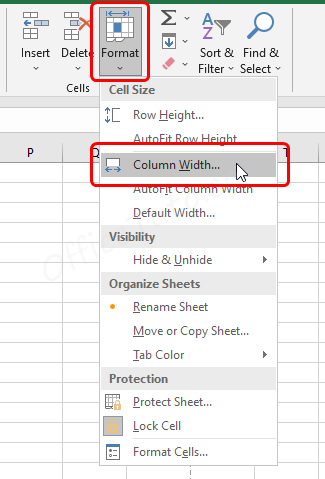
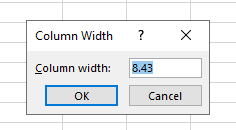
b- How to precisely resize columns in Excel using the right click
I will use here the “Column Width” dialog box displayed with the right click, to enter a precise value of the width I want.
To resize with a precision a column or multiple columns in Excel using the right click:
- Select the column or columns by the heading(s).
- Right-click the selection.
- Choose “Column Width” from the menu.
- Excel displays the “Column Width” dialog box.
- Set precisely the column width you want.
- Click OK to apply the new width.
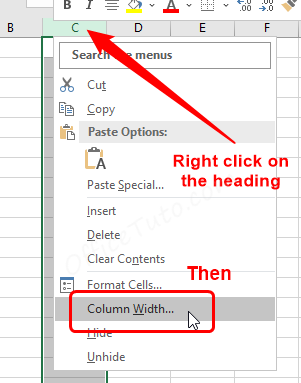
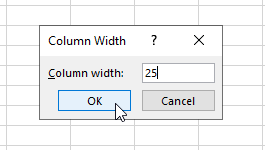
Note: The actual number of characters displayed within the width of the columns (in one line) depends of course on the font, size and style used.
3- Automatically adjust columns width in Excel to fit the content
The above methods of adjusting cell width work well for manual adjustments; however often times when adjusting the cell width, the goal is to be able to see all the content within that cell. When that is the desired goal, there is a quicker and automatic solution, and the end result is more consistent.
There are two ways to automatically adjust columns width in Excel:
- With the double click of the mouse.
- Through the autofit command from the ribbon.
a- Auto-adjust columns width in Excel with the double click
I will use here the first method of automatically adjusting columns width in Excel, which is using the double click of the mouse. I will apply it on a single column, as well as on multiple columns.
So, to automatically adjust one column width in Excel to fit the content of its cells:
- Place the cursor on the right boundary of the column heading.
- The cursor changes to a double-sided arrow.
- Double-click the mouse.
- Excel will automatically size the column to fit the largest content of its cells.
In the example of the screenshot below, the content of cell A1 is not entirely visible, so I use the double click on the heading of column A to autofit its width.
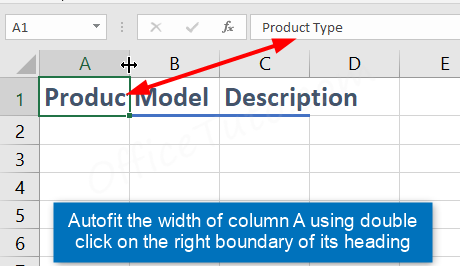
Here is the result after applying the autofit with double click on column A:
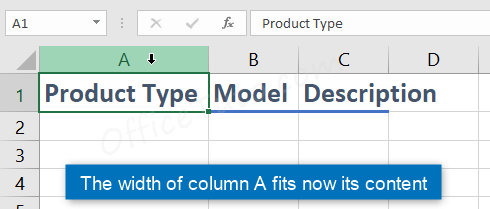
On the other hand, to automatically adjust the width of multiple columns in Excel to fit the content of their cells:
- Select the columns through their headings.
- Place the cursor on a boundary of any of these headings
- The cursor changes to a double-sided arrow.
- Double-click the mouse.
- Excel will automatically size each column to fit the largest content of its cells.
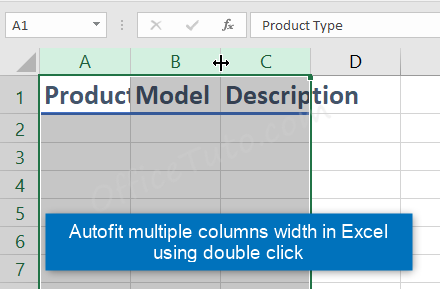
Here is the result after applying the autofit with double click on columns A, B and C:
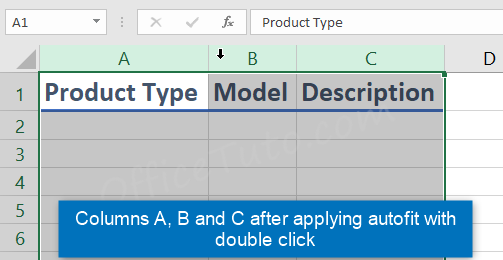
b- Automatically adjust cells or columns width in Excel via the ribbon
This is the second method of automatically adjusting cells or columns width in Excel, which is via the ribbon commands. I will show you how to autofit one cell or multiple cells width, as well as one or multiple columns width.
b1- Autofit one or multiple cells width in Excel using the ribbon
The ribbon command I will use here to autofit my cells is the “AutoFit Column Width” format command.
To automatically adjust one or multiple cells width in Excel to fit its content, using the ribbon:
- Select the cell or cells you want to autofit the width.
- Go to the “Cells” group of the “Home” tab.
- Click in the “Format” drop-down on “AutoFit Column Width”.
- Excel automatically adjusts the width of the column to fit the content of the selected cell or cells.
Note: If the content of any other cells is larger than the new size of the column, it will overflow to their right cell.
In the following example, I want to autofit the width of cells C2 and C3, because their width suits my needs, but not the other cells of column C that contain too long content, because of limited workspace; so, I preferred to apply the wrap text feature to these other cells, and autofit the first two cells of the column.
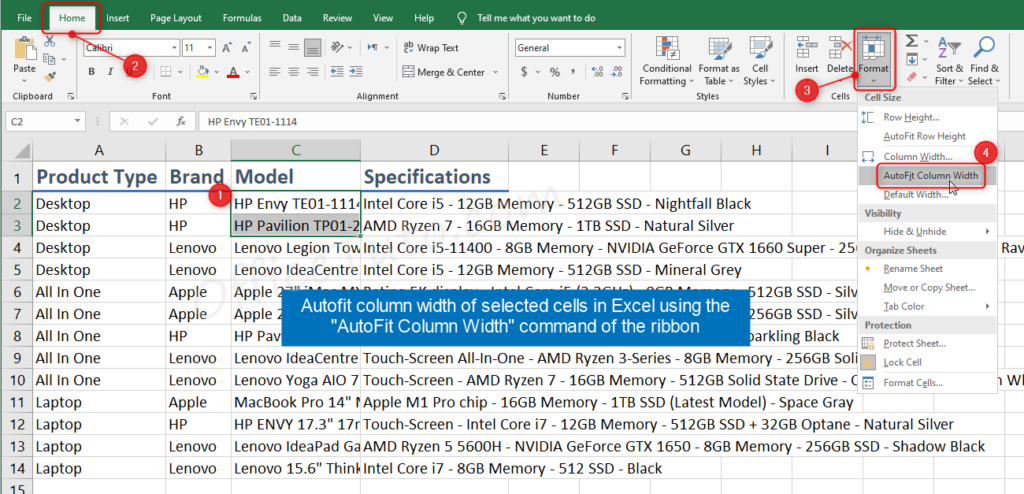
The result of applying the “AutoFit Column Width” format command on the selection of cells C2:C3 is illustrated below:
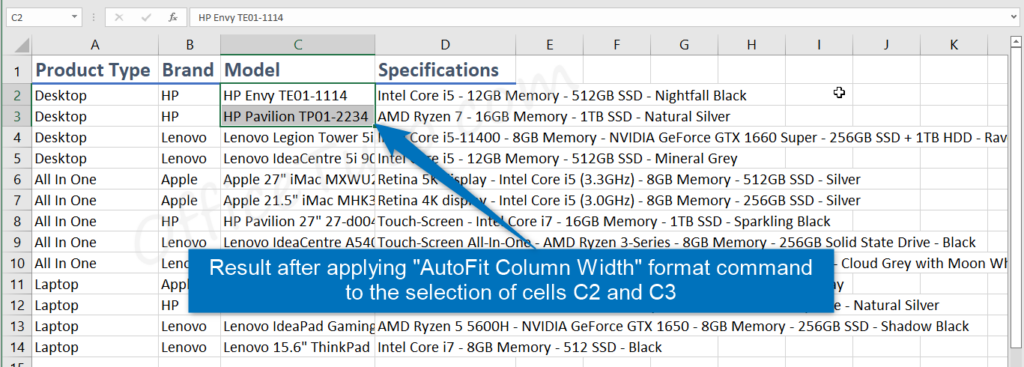
As you can see, the width of column C is adjusted to fit the content of the largest cell in the selection, which is cell C3 in my example. If there are any cells with a content longer than the width of C3, it will overflow to the next cell on the right if this cell is empty, or its extra will be hidden as you see in the screenshot above for the range C4:C14.
b2- Autofit one or multiple columns width in Excel using the ribbon
I will use here the “AutoFit Column Width” format command to autofit my columns.
To automatically adjust one or multiple columns width in Excel to fit the content, using the ribbon:
- Select the columns you want to autofit. If it’s just one column, you can simply click on a cell from it.
- Go to the “Cells” group of the “Home” tab.
- Click in the “Format” drop-down on “AutoFit Column Width”.
- Excel automatically adjusts the width of the selected column or columns, to fit the largest content of its or their cells.
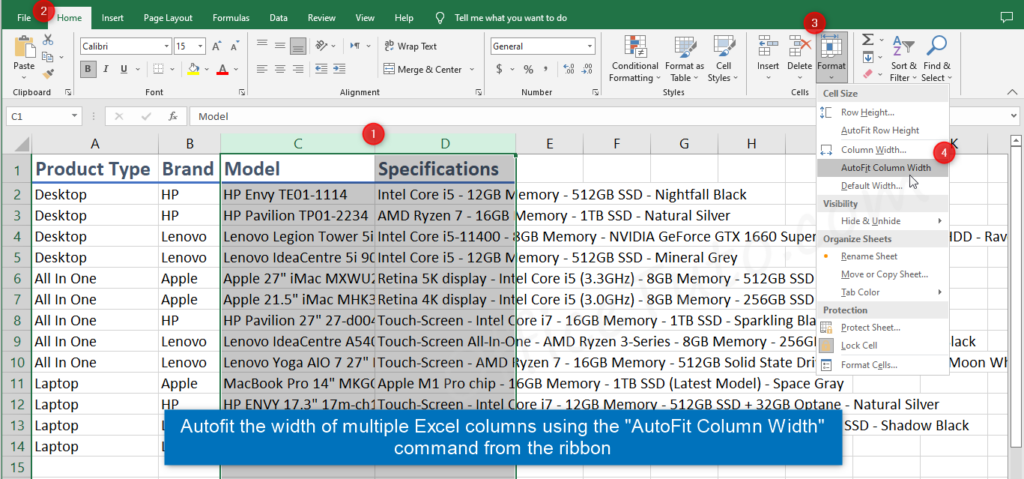
The result of applying the “AutoFit Column Width” command on the selected columns C and D is illustrated below:

As you can see, the width of column C is adjusted to fit the content of cell C14 (cell with the largest content in column C), and the width of column D is adjusted to fit the content of cell D4 (cell with the largest content in column D).
D/ How to resize a row in Excel
Often times, you’ll need to resize a row (or rows) in Excel when the text contained in it is wrapped or when there are multiple lines in the same cell.
The default row height in Excel is 15 points in the “Normal” view, or 0.21 inches in the “Page Layout” view (for a 100% scaling).
So, when you create a new spreadsheet, rows will have the default height; but you can of course change this height to the size you want.
Note also that you can set a new default height for rows in Excel; I detailed this in How To Set a New Default Column Width and Row Height in Excel.
Let’s see now how to change the row height in Excel.
There are 3 ways to resize rows in Excel:
- Dynamically, through the mouse drag and drop.
- Precisely, via the right click or the ribbon.
- Automatically fit the content of the cells (Autofit).
I will detail each method in the following sections:
1- How to resize a row in Excel dynamically via drag and drop
I will show you here the first method of automatically adjusting rows height in Excel, which is using the double click of the mouse.
To resize a row in Excel using the drag and drop of the mouse:
- Place the cursor on the bottom boundary of the row’s heading.
- The cursor is transformed to a double-sided arrow.
- Click and drag this bottom boundary to the bottom to widen the row, or to the top to narrow it.
To resize multiple rows in Excel using the drag and drop of the mouse:
- Select first the rows by their headings.
- Place the cursor on a boundary of any of these headings.
- The cursor is transformed to a double-sided arrow.
- Click and drag this boundary to the bottom to widen the rows, or to the top to narrow them.
- Excel changes the width of all selected rows.
In the example illustrated below, I’m increasing the height of rows 2 to 13 using the drag and drop of the mouse.
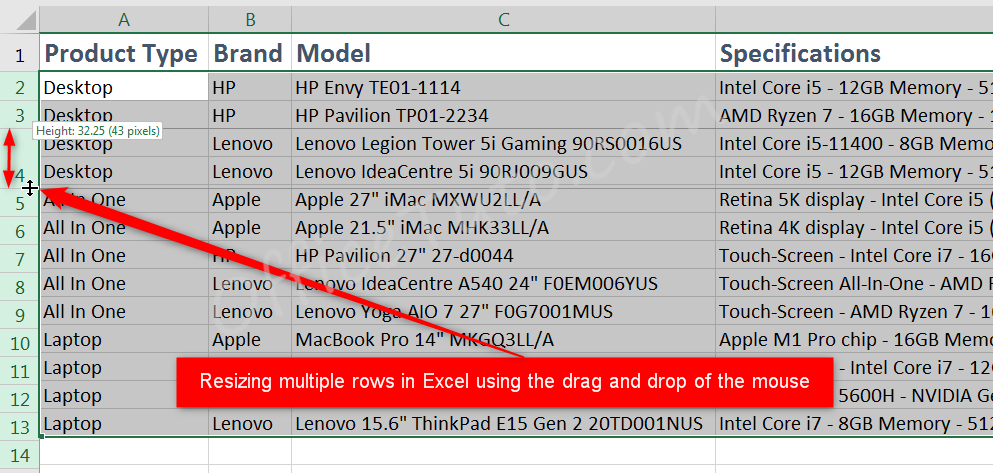
Here is the result:
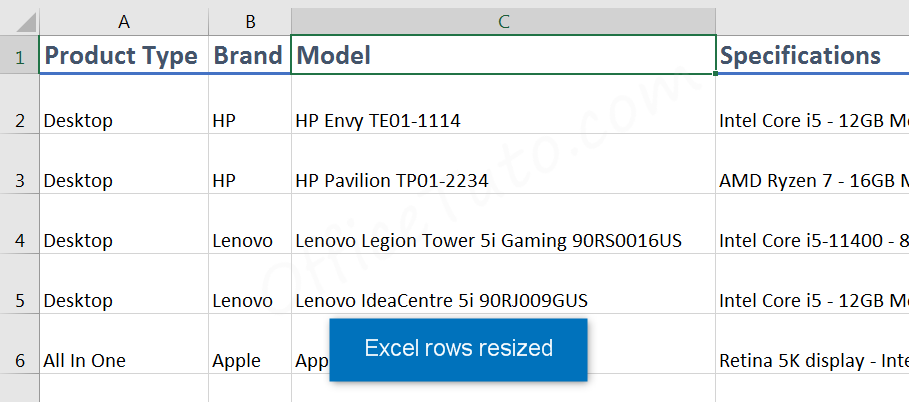
2- How to precisely resize rows in Excel via the dialog box
You can resize a row in Excel with a precise size that you can enter manually, using the right click or the ribbon.
So, to resize with a precision a row or multiple rows in Excel using the ribbon:
- Select the row or rows by the heading(s).
- Go to the “Cells” group of the “Home” tab.
- Click in the “Format” drop-down on “Row Height”.
- Excel displays the “Row Height” dialog box.
- Set how many points you want as a row height.
- Click OK to apply the new height.
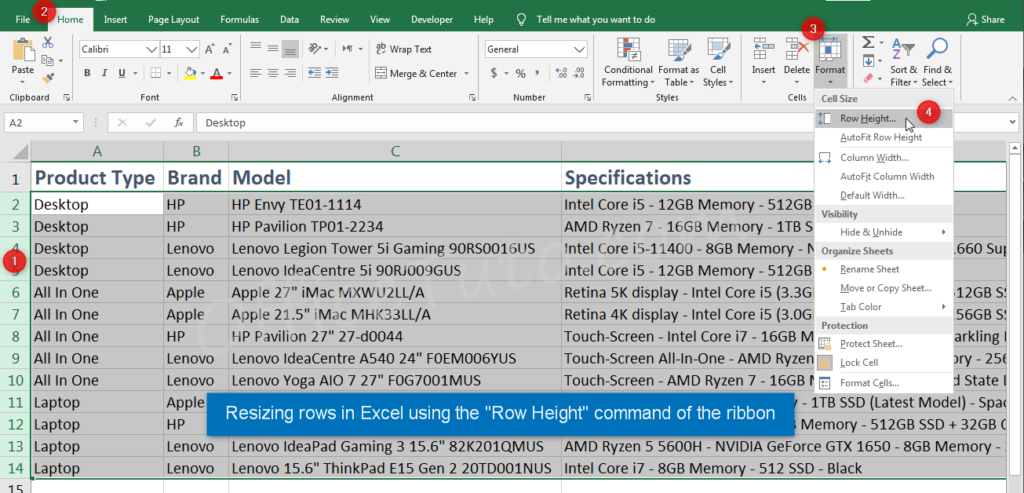
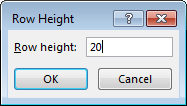
To resize with a precision a row or multiple rows in Excel using the right click:
- Select the row or rows by the heading(s).
- Right-click the selection.
- Choose “Row Height” from the menu.
- Excel displays the “Row Height” dialog box.
- Set how many points you want as a row height.
- Click OK to apply the new height.
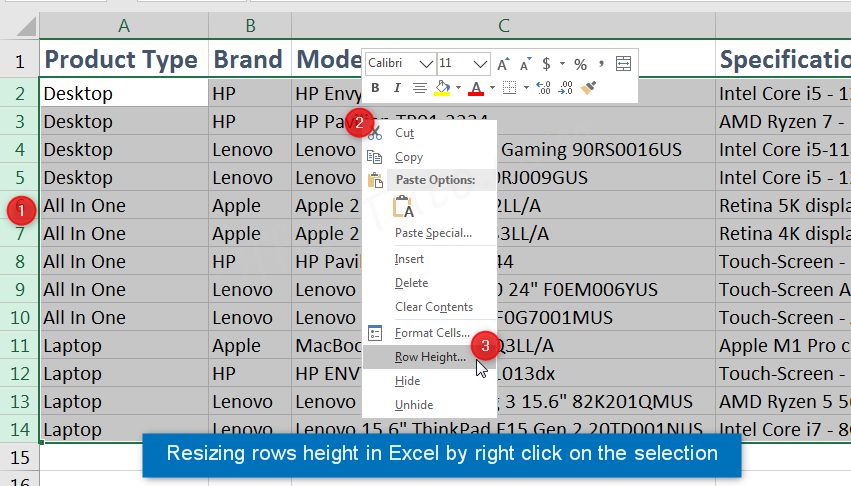
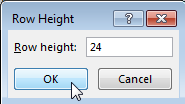
3- Automatically adjust rows height in Excel to fit the content
The above methods of adjusting cell height work well for manual adjustments as you control yourself the row size; however, when you want to fit the row height to its content, there is a quicker and automatic solution, that will give you a more precise result.
However, there is one condition for the autofit to work on the row(s): a manual adjustment must have been applied beforehand on the row(s) for the autofit to be effective and be able to correct the manual adjustment.
There are two ways to automatically adjust rows height in Excel:
- With the double click of the mouse.
- Through the autofit command from the ribbon.
a/ Auto-adjust rows height in Excel with the double click
I will use here the first method of automatically adjust rows height in Excel, which is using the double click of the mouse.
So, to automatically adjust one row height in Excel to fit the content of its cells, provided of course that a manual adjustment was previously applied on:
- Place the cursor on the bottom boundary of the row heading.
- The cursor changes to a double-sided arrow.
- Double-click the mouse.
- Excel will automatically size the row to fit the longest wrapped or multi-line content of its cells.
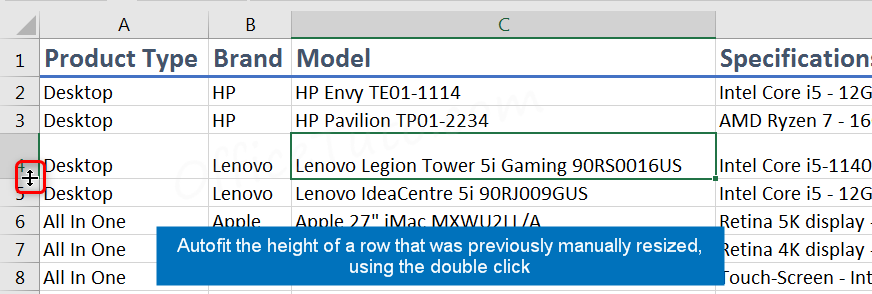
On the other hand, to automatically adjust the width of multiple rows in Excel to fit the content of their cells, provided of course that a manual adjustment was previously applied on:
- Select the rows through their headings.
- Place the cursor on a boundary of any of these headings.
- The cursor changes to a double-sided arrow.
- Double-click the mouse.
- Excel will automatically size each row to fit the longest content of its cells.
b/ Automatically adjust cells or rows height in Excel via the ribbon
This is the second method of automatically adjust cells or rows height in Excel, which is via the autofit command of the ribbon.
So, to automatically adjust one cell or row height in Excel to fit its content, using the ribbon:
- Select a cell from the row.
- Go to the “Cells” group of the “Home” tab.
- Click in the “Format” drop-down on “AutoFit Row Height”.
- Excel automatically adjusts the height of the row to fit the longest content of the row cells.
In the example below, I’m applying the “AutoFit Row Height” command on row 4 (a row that was manually adjusted previously):
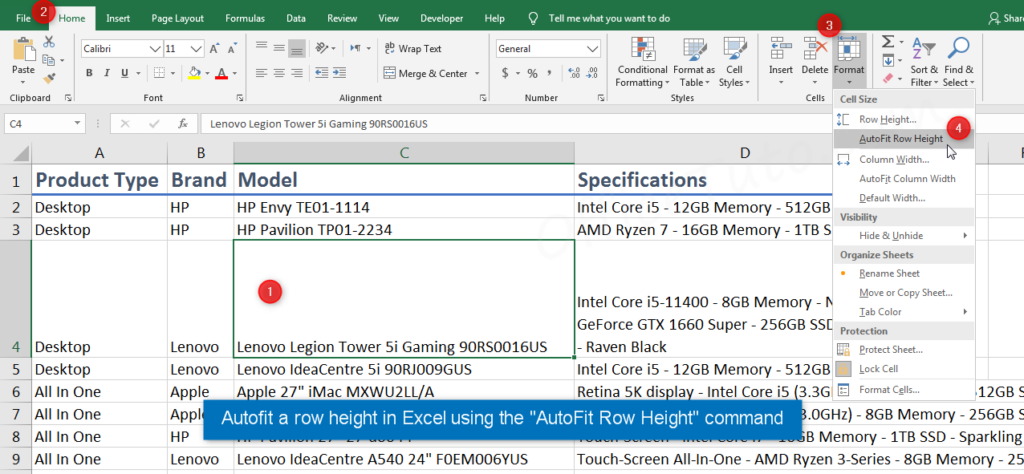
The result is illustrated below:

As you can see, the row height was automatically adjusted to fit the longest content of its cells, which is the content of cell D4.
To automatically adjust multiple rows height in Excel to fit the content, using the ribbon:
- Select the rows you want to autofit.
- Go to the “Cells” group of the “Home” tab.
- Click in the “Format” drop-down on “AutoFit Row Height”.
- Excel automatically adjusts the height of the selected rows.
- Each row fits the longest content of its cells.
E/ Drawback of Excel autofit compared to the manual resizing
If we can automatically resize columns and rows in Excel with the help of the autofit feature, then why the need of any manual resizing?
The drawback of Excel autofit is that it resizes columns to the largest content of the cells and resizes rows to the longest content of the cells, which causes an issue for the columns or rows containing cells with long content, as they will exceed the display and you’ll need to scroll right and left for the columns or down and up for the rows to view the whole content.
There are three solutions to this autofit issue causing the display overflow in Excel:
- Manually adjust the columns width and rows height,
- and/or wrap text for the cells with large/long content,
- and/or zoom out using the “Zoom” tool at the bottom right of the sheet.
The third solution is not very practical, but it can help you a little to get the optimal display. I personally prefer the two first solutions.
F/ How to make excel columns or rows the same size
You can make Excel cells the same height and width using two methods: with the drag and drop of the mouse, or using the “Column Width” or the “Row Height” dialog box.
1- How to make Excel columns the same width
Note: I will show you here how to make multiple columns the same width, in one time; this is different than taking the width of one or multiple columns, then applying it in a second time to another ones; for this, you can check How To Copy Columns Width and Rows Height in Excel.
a- How to make Excel columns the same width via drag and drop
To set the same width to multiple columns in Excel using the drag and drop of the mouse:
- Select the columns by their headings.
- Place the cursor on a boundary of any heading of these columns.
- The cursor is transformed to a double-sided arrow.
- Click and drag this boundary to the right to widen the columns, or to the left to narrow them.
- All selected columns will take the same size you set.
In the following example, I’m applying the same width to columns A and B using the drag and drop of the mouse:
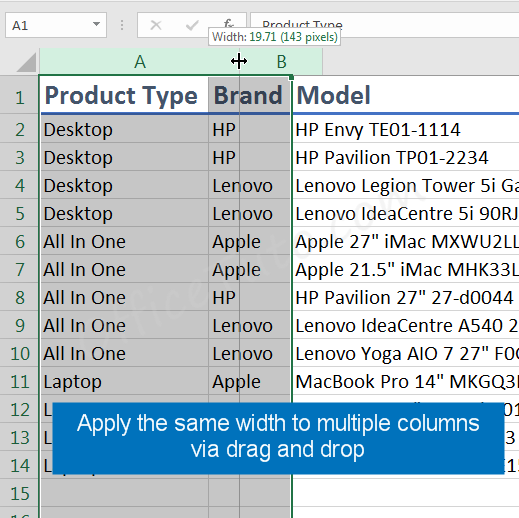
The result is illustrated below:
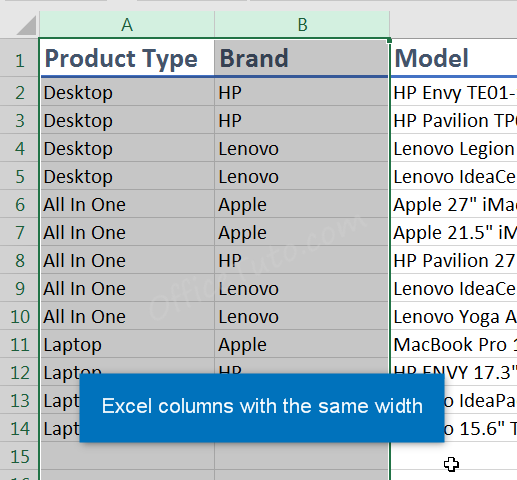
b- How to make Excel columns the same width via the dialog box
You can set precisely the same width to multiple Excel columns via the “Column Width” dialog box, using the right click or the ribbon.
So, to set precisely the same width to multiple Excel columns using the ribbon:
- Select the columns by their headings.
- Go to the “Cells” group of the “Home” tab.
- Click “Column Width” in the “Format” drop-down.
- Excel displays the “Column Width” dialog box.
- Set precisely the column width you want.
- Click OK to apply the new width to all columns.
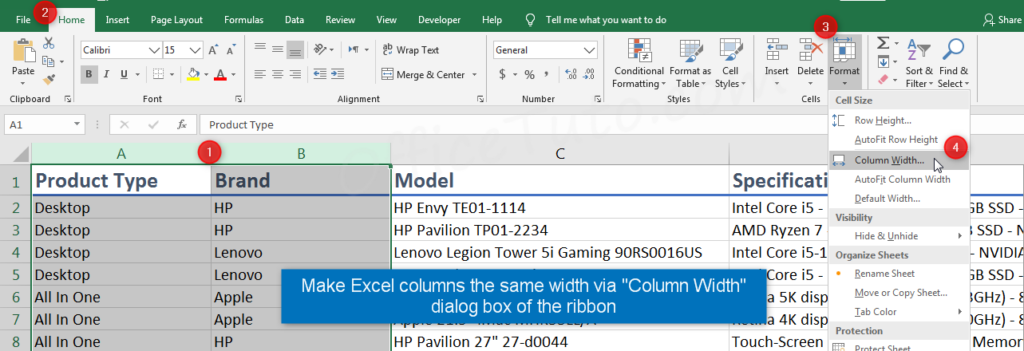
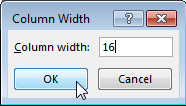
The result of making the same width to columns A and B is illustrated below:
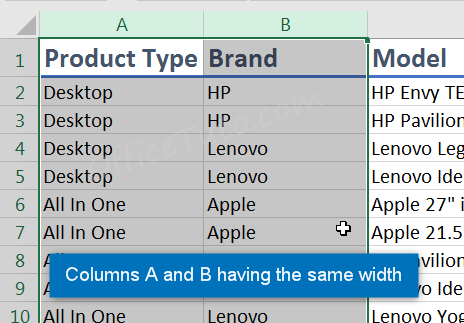
To set precisely the same width to multiple Excel columns using the right click:
- Select the columns by their headings.
- Right-click on the selection.
- Choose “Column Width” from the contextual menu.
- Excel displays the “Column Width” dialog box.
- Set precisely the column width you want.
- Click OK to apply the new width to all columns.
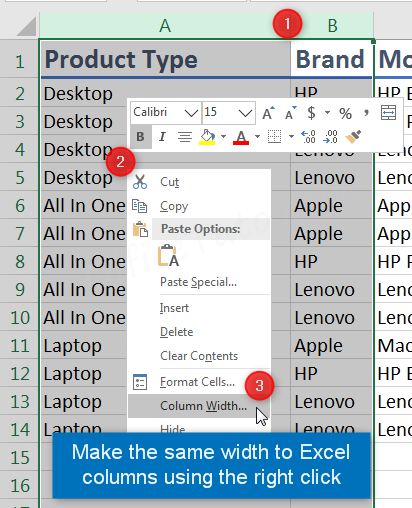
Note: The actual number of characters displayed within the width of the columns (in one line) depends of course on the font, size and style used.
2- How to make Excel rows the same height
Note: I will show you here how to make multiple rows the same height, in one time; this is different than taking the height of one or multiple rows, then applying it in a second time to another ones; for this, you can check How To Copy Columns Width and Rows Height in Excel.
a- How to make Excel rows the same height via drag and drop
To set the same height to multiple rows in Excel using the drag and drop of the mouse:
- Select these rows by their headings.
- Place the cursor on a boundary of any heading of these rows.
- The cursor is transformed to a double-sided arrow.
- Click and drag this boundary to the bottom to widen the rows, or to the top to narrow them.
- All selected rows will take the same size you set.
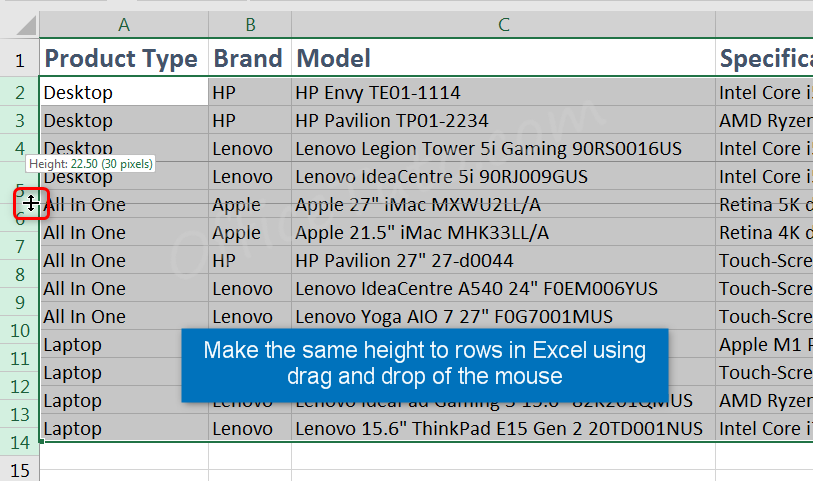
b- How to make Excel rows the same height via the dialog box
You can set precisely the same height to multiple Excel rows via the dialog box, using the right click or the ribbon.
So, to set precisely the same height to multiple Excel rows using the ribbon:
- Select these rows by their headings.
- Go to the “Cells” group of the “Home” tab.
- Click in the “Format” drop-down on “Row Height”.
- Excel displays the “Row Height” dialog box.
- Set how many points you want as a row height.
- Click OK.
- The new height is applied to all selected rows.
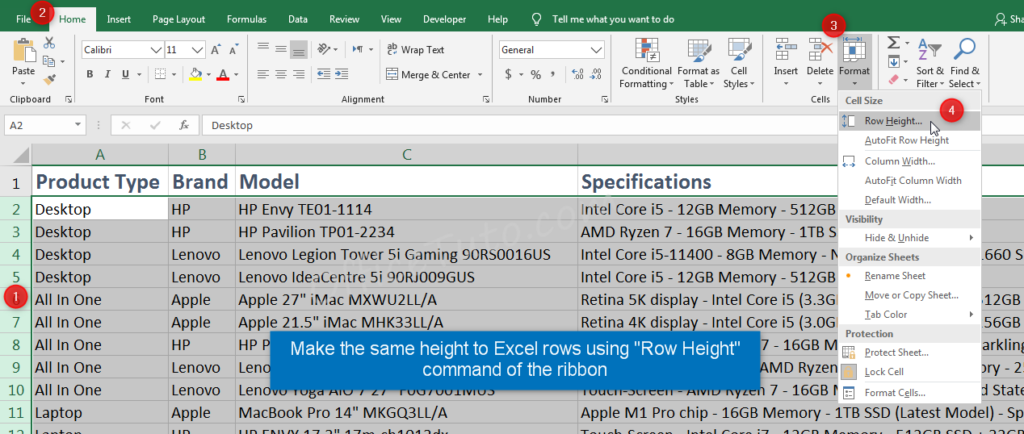
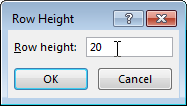
To set precisely the same height to multiple Excel rows using the right click:
- Select these rows by their headings.
- Right-click on the selection.
- Choose “Row Height” from the contextual menu.
- Excel displays the “Row Height” dialog box.
- Set how many points you want as a row height.
- Click OK.
- The new height is applied to all selected rows.
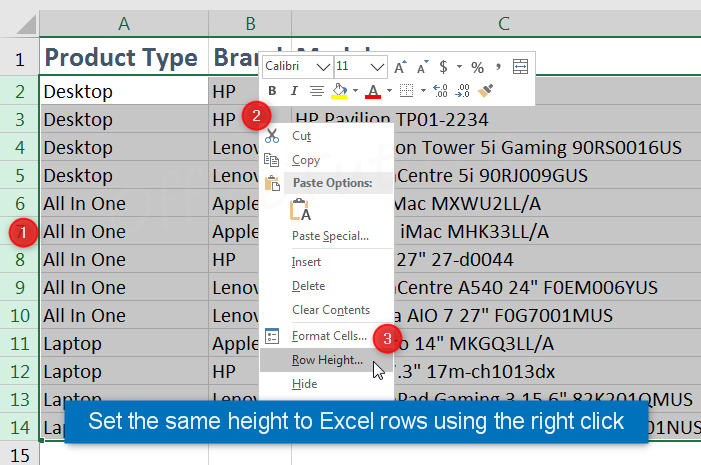
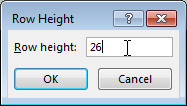
G/ Wrap up
That’s all for this tutorial where I showed you how to know the current column width or row height in Excel, what are the minimum and maximum sizes of a cell, how to resize a column or a row, and how to make multiple columns or rows the same size. I also discussed the problem that is sometimes caused by the autofit feature of Excel compared to the manual resizing, and how to correct it.
Jeff Golden is an experienced IT specialist and web publisher that has worked in the IT industry since 2010, with a focus on Office applications.
On this website, Jeff shares his insights and expertise on the different Office applications, especially Word and Excel.
By default, when you create a new workbook in Excel, the row height and column width is always the same for all cells. However, you can easily change the height and width for one or more rows and columns.
For new Excel workbooks, the default row height for all the rows is 15, with the default font of Calibri and default font size of 11 points. The default column width for all the columns is 8.38. The default row height for each row depends on the largest font and font size chosen in any of the cells in that row (you can assign different fonts and font sizes for different cells). However, you can choose a specific height for any of the rows as well as a specific column width for any of the columns. The height can be different for different rows and the width different for different columns.
If you want to adjust one row, you can move the cursor over the bottom border of the row heading until it turns into a bar with a double arrow. Then, click on the border and drag it up or down to change the height of the row above the border. As you drag the cursor, the changing height displays in a popup.
You can do the same thing to change the width of a column: drag the double-arrow cursor to the left or right on the right border of the column. The width of the column to the left of the border changes width. The width of other columns are not affected.
RELATED: How to Show and Hide Row and Column Headers in Excel
You can be more exact when specifying the height of one or more rows by entering a specific number for the height. To do this, move your mouse over a row heading until it turns into a right arrow. Then, click on the row heading to select the entire row. If you don’t see the row headings, they might be hidden.
To select more than one row, click on the first row heading you want to select and drag up or down to select contiguous rows. If the rows you want to select are not contiguous, click the first row heading and then press Ctrl and click on the headings for the other rows you want to select, just like you do to select multiple files in File (or Windows) Explorer.
Either right-click on any selected row or press Shift+F10 on your keyboard. Select “Row Height” from the popup menu.
Enter a new value for the row height for the selected rows on the Row Height dialog box and click “OK”.
NOTE: You should note what the default, or original, values for row height and column width are before changing them, in case you want to revert back to those values.
You can specify an exact width for one or more columns the same way. Select the columns using the column headings, just like you did for the rows, but drag left or right to select multiple contiguous rows. Then, press Shift+F10 and select “Column Width” from the popup menu.
Enter an exact width for the selected columns on the Column Width dialog box and click “OK”.
Here’s what our worksheet looks like with the height of the first three rows and the width of the first three columns changed.
You can change the row height back to the default height, but it many not necessarily be the standard default height. The current default height will be one that fits the largest font and font size used in that row. In other words, the row height of the selected row will be changed to automatically fit the contents of that row.
To automatically fit the row height, select the rows you want to resize to their default height, make sure the Home tab is active, click “Format” in the Cells section, and then select “AutoFit Row Height” from the Cell Size drop-down menu.
To automatically fit one row, you can move the mouse over the bottom border of the desired row heading until it turns into a bar with a double (up and down) arrow, just like when you dragged the border to change the row height. This time, double-click on the border. The row height changes to fit the largest font and font size used in that row.
There is also an option to autofit the width of selected columns, but it works slightly differently. The AutoFit Row Height options automatically changes the row height to fit the largest font and font size whether or not there is any content in any cells in that row.
When you select one or more columns and then select “AutoFit Column Width” from the “Cell Size” menu in the Cells section of the Home tab, a selected column will only change size if there is content in any cell in that column. Otherwise, if all the cells in the column are empty, the size of that column will not be affected.
You can also automatically change the width of a column to fit the widest contents in that column by moving the mouse over the border on the desired column heading until it turns into a bar with an double (left and right) arrow, just like when you dragged the border to change the column width. This time, double-click on the border. The column width changes to fit the widest cell contents in that column. This also only works on columns that are not completely empty.
Because the default row height is affected by the font and font size assigned to the cells in each row, you cannot specify a value for the default row height. However, the default column width for all the columns in the current worksheet can be changed. To specify a different column width for all the columns in the current worksheet, make sure the Home tab is active, click “Format” in the Cells section, and then select “Default Width” from the Cell Size drop-down menu.
Enter a value for the Standard column width on the Standard width dialog box and click “OK”. The width of all the columns on the current worksheet change to the specified width, no matter how wide the contents are in any of the cells.
RELATED: How to Hide Cells, Rows, and Columns in Excel
You can also convert rows into columns and columns into rows, delete blank rows and columns, hide rows and columns, freeze rows and columns, and print the row and column headings in Excel.
READ NEXT
- › How to Shrink Text to Fit a Cell in Microsoft Excel
- › How to Insert a Picture in Microsoft Excel
- › How to Resize All Columns and Rows in Microsoft Excel
- › How to Use the IMAGE Function in Microsoft Excel
- › How to Set Row Height and Column Width in Excel Using the Keyboard
- › How to Lock Column Width and Row Height in Microsoft Excel
- › How to Shrink or Expand Cells to Fit Text in Microsoft Excel
- › Android’s Nearby Share Has (Unofficially) Arrived on Mac


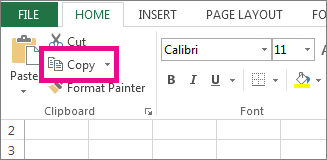
 button.
button.


 > Excel Options> Advanced.
> Excel Options> Advanced.



 at the top of the worksheet, to select all columns and rows.
at the top of the worksheet, to select all columns and rows.

